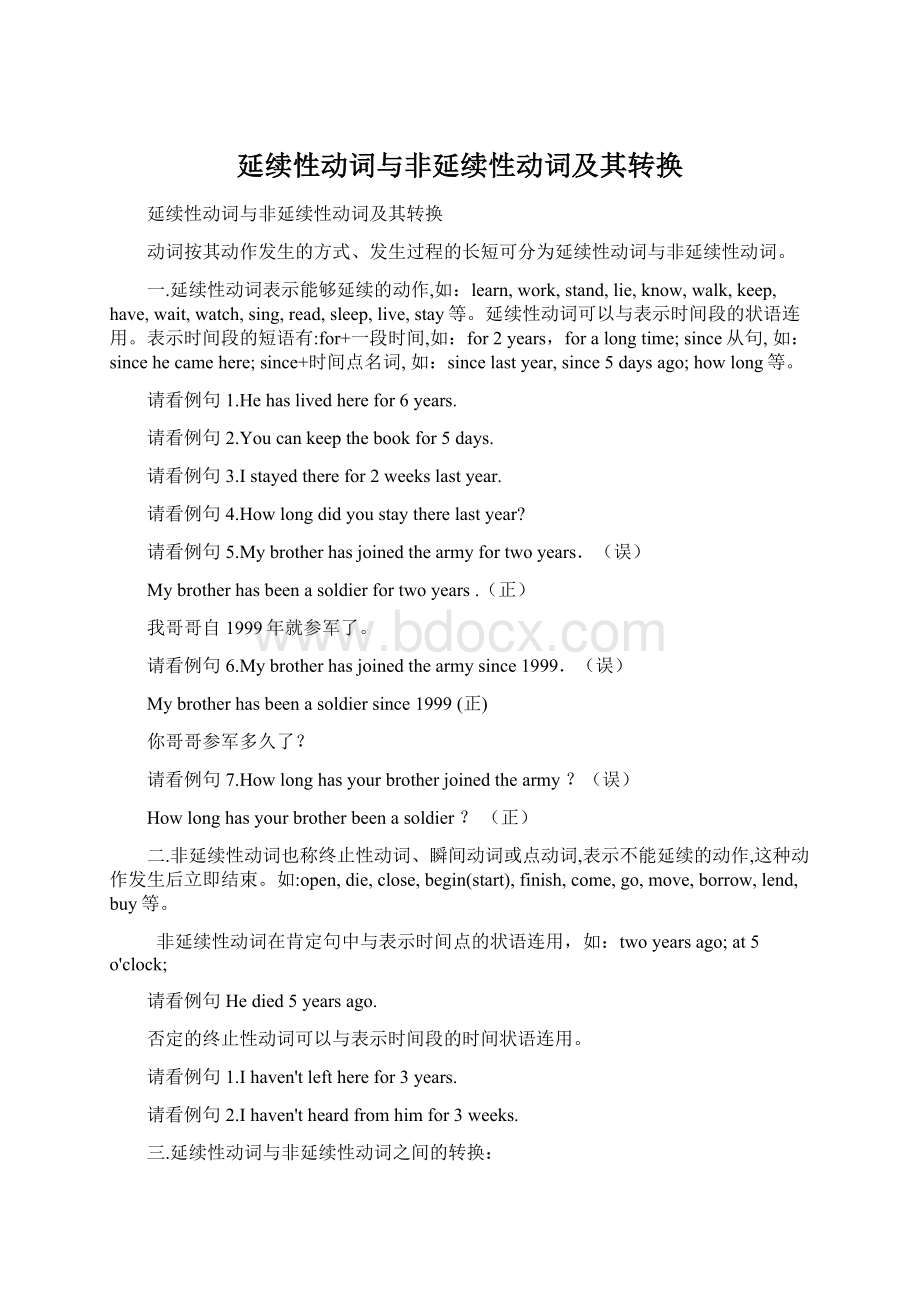 延续性动词与非延续性动词及其转换Word文档下载推荐.docx
延续性动词与非延续性动词及其转换Word文档下载推荐.docx
- 文档编号:16162295
- 上传时间:2022-11-21
- 格式:DOCX
- 页数:11
- 大小:23.74KB
延续性动词与非延续性动词及其转换Word文档下载推荐.docx
《延续性动词与非延续性动词及其转换Word文档下载推荐.docx》由会员分享,可在线阅读,更多相关《延续性动词与非延续性动词及其转换Word文档下载推荐.docx(11页珍藏版)》请在冰豆网上搜索。

非延续性动词在肯定句中与表示时间点的状语连用,如:
twoyearsago;
at5o'
clock;
请看例句Hedied5yearsago.
否定的终止性动词可以与表示时间段的时间状语连用。
请看例句1.Ihaven'
tleftherefor3years.
请看例句2.Ihaven'
theardfromhimfor3weeks.
三.延续性动词与非延续性动词之间的转换:
leave→beaway离开;
borrow→keep借;
buy→have买;
begin/start→beon开始/上演;
die→bedead;
finish/end/stop→beover结束/完成;
join→bein+组织机构或beamemberof+组织机构;
open/closesth→keepsthopen/closed;
fallill→beill;
getup→beup;
catch/getacold→haveacold感冒;
comehere→behere;
gothere→bethere;
become→be成为;
comeback→beback;
fallasleep→beasleep睡着;
getto/arrive/reach→be(in);
leave→beawayfrom;
gettoknow→know;
go(get)out→beout;
puton→wear;
catchacold→haveacold;
gotoschool→beinschool/beastudent上学;
goabroad→beabroad去国外;
marry→bemarried(to)结婚;
wakeup→beawake醒;
makefriendswith→befriendswith成为/交朋友;
lose→belost/bemissing/begone丢失;
loseone'
sjob/work→beoutofwork/ajob等。
请看例句1.Theoldmandied4yearsago.
→Theoldmanhasbeendeadfor4years.
→Itis4yearssincetheoldmandied.
→Fouryearshaspassedsincetheoldmandied.
请看例句2.HejoinedtheParty2yearsago.
→HehasbeeninthePartyfor2years.
→HehasbeenaPartymemberfor2years.
请看例句3.Hejoinedthearmy5yearsago.
→Hehasbeeninthearmyfor5years.
→Hehasservedinthearmyfor5years.
→Hehasbeenasoldierfor5years.
请看例句4.Iboughtthebook5daysago.
→Ihavehadthebookfor5days.
练习:
1.Whenhearrivedatthebusstop,thebus________for20minutes.
A.hasleftB.hadleftC.hasbeenawayD.hadbeenaway
2.I______theLeaguefor5yearssofar.
A.joinedB.havejoinedC.havebeenin
3.Thefactory________sincetheFebruaryof1988.
A.hasbeenopenB.hasopenedC.wasopenD.opened
4.MaryandRose_______friendssincetheymetin2000.
A.havemadeB.havebeenC.madeD.havebecome
5.Youmustn'
t________untilhecomesback.
A.beawayB.leaveC.beleft
6.Themeeting_______foraweeknow.
A.hasfinishedB.hasendedC.hasbeenover
7.MissGao______thisschoolfornearly5years.
A.hasbeeninB.hascometoC.hastaught
8.Ben______ateacherfor4years.
A.hasbeenB.hasbecomeC.wasD.became
9.I______homeforaweek.
A.havereturnedB.havebeenbackC.returned
10.Howlong_______he________?
A.diedB.has,diedC.has,beendead
11.He______ateightyesterdayafternoon.
A.sleptB.wassleepingC.hassleepD.hadslept
12.He________thecarforaweek.
A.boughtB.hasboughtC.hashad
13.-----Howlong_____you_____ill?
-----Twoweeks.
A.didfallB.have,fellC.have,been
14.Since2000,he_____hishometown.
A.hasleftB.hasmovedawayC.hasbeenawayfrom
15.I'
lllendyouthebook,butyoucanonly_____itfor2days.
A.borrowB.keepC.take
16.Thebus______ontheroadfor2hourssofar.
A.hasstoppedB.stoppedC.hasbeen
17.Areyou_____thejacketthesedays?
A.wearingB.puttingonC.dressingD.on
18.He________foe2hours.
A.gotupB.hasgotupC.hasbeenup
19.Tomisillinhospital.He_______acoldforseveraldays.
A.isB.catchesC.hascaughtD.hashad
20.-----HowlongcanI______thebook?
------Twoweeks.
A.borrowB.lendC.getD.keep
21.---Howlonghaveyou________thebook?
---Twoweeks.
A.boughtB.lentC.hadD.borrowed
22.---Doyouknowhimwell?
---Sure,we________friendsfortenyears.
A.wereB.havebeenC.havebecomeD.havemade
Key:
1---5DCABB;
6---10CAABC;
11---15BCCCB;
16---20CACDD;
21---22CB
英语形容词的排列顺序
当两个以上形容词修饰一个名词,形容词该如何排列?
这一直是一个比较复杂的问题,很多英语学习者发现难以找到适合自己的记忆方法。
下面的口诀可否帮你记住这一先后顺序。
限定描绘大长高,形状年龄和新老;
颜色国籍跟材料,功能类别往后排。
“限定词”包括:
冠词、物主代词、指示代词、或数词,它位于各类形容词前。
它本身分为三位,即:
前、中、后。
前位限定词有all、half、both、分数和倍数;
中位限定词有冠词、指示代词、物主代词等;
后位限定词有基数词和序数词,但序数词位于基数词前。
bothmyhands、allhalfhisincome等。
“描绘”性形容词如:
beautiful、bad、cold、great等。
“大长高”表示大小、长短、高低等一些词。
“形状”的词如:
narrow、round、square等。
“国籍”指一个国家或地区的词,如:
British、Canadian、German等。
“材料”的词如:
plastic、metal、wooden、woolen、stone、silk等。
“功能类别”的词如:
writingdesk、policecar等。
当然,实际语言使用中不可能出现这么多形容词连用的情况。
请多读以下例子增加语感:
1.Shehasabeautifulbrownleatherjacket.
2.HehasalongredAmericancar.
3.Theyliveinabeautifuloldhouse.
4.Wehaveasmallantiquewoodentable.
5.Hehasalovelyredwoollenjumper.
6.ItisaprettylittlesquareoldblackJapanesewoodenwritingdesk.
7.ItwasalovelyoldFrenchsong.
8.Heownsahorriblebigblackdog.
9.ThisisabeautifulshortnewredChinesewoollencoat.
10.IsawafantasticnewBritishfilm.
11.ThisprettylittleSpanishgirlLinda’sconusin.
12.Oh,it’sanicelongnewblackBritishplasticpen.
13.Iamatall,strongandintelligentstudent.
我是一个身高体壮而又聪明的学生。
14.Iamdressedinashortbluesilkcoat.
我穿一件短的蓝色绸缎外衣。
15.Thisnewshoppingmallisquitelarge,isn'
tit?
这家新开的购物中心真大,是吧?
16.anexpensivetennisracket
一个很贵的网球拍
17.alargebrickconferencehall
一间大的砖造的会议室
18.Thispairofsteelandnylontennisracketsisreallyexpensive.
这副钢和尼龙制造的网球拍真贵啊。
19.alargebrickconferencehall
20.afinelittleearthendoll
一个精巧的小小的泥娃娃
21.DoyouhaveItalianleatherboots?
这有义大利制造的皮靴吗?
22.IwantapairofblackItalianleatherboots.
我想要一双黑色义大利制造的皮靴。
23.Mom,couldyoubuymeanewgreenleatherschoolbag?
妈妈,你能为我买一个新的绿色皮书包吗?
24.Ithinkyouroldcanvasschoolbagisstillusable.
我觉得你那个旧帆布书包还能用。
25.Thatlargegreenleatherschoolbagisreallycool.
那个大大的绿色皮书包真棒啊!
26.Yes,itreallyis.Andthatprettypurplesilkdress!
确实很棒。
还有那件漂亮的紫色的丝质衣服也很棒。
27.WhataboutthosebeautifullittleoldChineseporcelainvases?
那些漂亮的小小的古老的中国瓷花瓶怎么样?
分英语中的反意疑问句
(2)
英语中的反意疑问句(TagQuestion)
在陈述句后面附加一个简短问句,对陈述句所叙述的事实提出相反的疑问,这种句子叫做反意疑问句,也称为附加疑问句,是一种常用的疑问形式。
常用于征求对方的意见和看法,要求对方对自己的话语表示肯定或否定的回答。
反意疑问句也可以表示问者的倾向,强调或反问。
要注意的是要保持人称,时态和数的一致而且附加疑问部分通常用代词,而不用同陈述部分相应的名词。
一.附加疑问部分谓语是have(has/had),表示‘‘所有’’含义时,陈述部分如是肯定式,附加疑问部分谓语用‘‘haven’t(hasn’t/hadn’t)…?
’’或‘‘don’t(doesn’t/didn’t)…?
’’;
陈述部分如是否定式,‘‘haven’t(hasn’t/hadn’t)…’’时,附加疑问谓语只用‘‘have(has/had)…?
陈述部分如是否定式,‘‘don’thave(doesn’thave/didn’thave)…’’时,附加疑问部分谓语只用‘‘do(does/did)…?
’’。
如:
1.HehasanewTVset,hasn’t/doesn’the?
2.Youhaven’talotoftimetospare,haveyou?
3.Hehadastory-bookyesterday,hadn’t/didn’the?
4.Shedidn’thaveanymoneyinherpocket,didshe?
5.Youdon’thaveanymoneyinyourpocket,doyou?
注1:
陈述部分谓语如带有助动词,附加疑问谓语也用相应的助动词,所以上面最后两句附加疑问部分谓语用助动词did/do,而不能用动词had/have。
注2:
陈述部分的谓语动词‘‘have(has/had)’’不表示‘‘所有’’含义,而又不是助动词,附加疑问部分谓语只用‘‘do(does/did)…?
’’。
如:
1.Katehastoworkharderfromnowon,doesn’tshe?
2.Sheoftenhasheadaches,doesn’tshe?
3.Youhadagoodtimelastnight,didn’tyou?
二.陈述部分为祈使句时,附加疑问部分一般用willyou,但有时用won’tyou表示‘‘邀请’’之意,这种情况的附加疑问部分也用whydon’tyou构成。
也有时用wouldyou,canyou,can’tyou来表示‘‘告诉某人该做某事,请求某人该做某事,提醒某人该做某事’’。
1.
Pleasekeepcalm,willyou?
2.
Doasyouweretold,willyou?
3.
Bequiet,wouldyou?
(表示请求)
4.
Givemeahand,can/can’tyou?
(表示请求)
5.
Sitdown,won’tyou?
(表示邀请)
6.
Havesomemilk,won’t?
7.
Takeabreak,whydon’tyou?
注1:
此种情况在水平测试中,一般以willyou为准。
特别是在否定形式中,只能用willyou。
1.Don'
tforqettogetupearly,willyou?
2.Don’tdothat,willyou?
祈使句以let开头时,附加疑问部分应特别注意。
Let’s所建议的活动指说话者与听话者双方的行为,Let’s…意思即shallwe…,附加疑问部分是shallwe意思的重复;
而Letus/Letme向听话者一方提出请求,是请你让我们/我做某事之意。
Letus…意即maywe…或willyouletus…,附加疑问部分用maywe或willyou来表示重复。
Letme…意即mayI…或willyouletme…,附加疑问部分用mayI或willyou来表示重复。
It’safineday.Let’sgofishing,shallwe?
ComeonMary,let’sdance,shallwe?
Letusgotothecinemathisafternoon,maywe/willyou?
LetmesayI’llthinkitover,mayI/willyou?
三.陈述部分带有否定或半否定的副词或代词,如:
none,scarecely,neither,noone,few,seldom,never,hardly,rarely,little,nowhere,nothing或nobody等,附加疑问部分谓语用动词用肯定形式。
1.Shenevertellsalie,doesshe?
2.Fewpeoplewenttomeethimyesterday,didthey?
3.Sheseldomgoestoworklate,doesshe?
Nothingwassaid,wasit?
Tomhardlydidhishomework,didhe?
Hehadnotimeforreading,didhe?
注:
带有否定意义的形容词,如:
unfair,invisible,undrinkable,unfit,useless,impolite,hopeless等,不属于带有否定或半否定的副词或代词,故后面的附加疑问部分要用否定形式。
1.That'
sunfair,isn'
tit?
2.Theyareunhappy,aren’tthey?
3.Thekingisunfitforhisoffice,isn’the?
4.Thewaterintheareaisundrinkable,isn’tit?
四.陈述部分如果是主从复合句时,附加疑问部分谓语动词根据主句的谓语动词而定;
陈述部分如果是并列复合句时,附加疑问部分谓语动词根据后句的谓语动词而定。
1.Itisnotcolderthanitwasyesterday,isit?
2.HetoldherMrs.Smithwasn’tgoingtothemeeting,didn’the?
3.YouwereinthefarmwhenIsawyoulastnight,weren’tyou?
4.HesaysthatIdidit,doesn’the?
5.Johnisn’tadiligentstudent,foritisthethirdtimehehasbeenlate,ishe?
6.ItisthesecondtimethatMaryhasbeentoChina,isn’tit?
7.Timeisupandlet’sbeginourmeeting,shallwe?
think,suppose,expect,feel,hear,guess,imagine,besure或believe引导的宾语从句,主句中主语是第一人称时,附加疑问部分谓语动词根据从句的
- 配套讲稿:
如PPT文件的首页显示word图标,表示该PPT已包含配套word讲稿。双击word图标可打开word文档。
- 特殊限制:
部分文档作品中含有的国旗、国徽等图片,仅作为作品整体效果示例展示,禁止商用。设计者仅对作品中独创性部分享有著作权。
- 关 键 词:
- 延续性 动词 及其 转换
 冰豆网所有资源均是用户自行上传分享,仅供网友学习交流,未经上传用户书面授权,请勿作他用。
冰豆网所有资源均是用户自行上传分享,仅供网友学习交流,未经上传用户书面授权,请勿作他用。


 广东省普通高中学业水平考试数学科考试大纲Word文档下载推荐.docx
广东省普通高中学业水平考试数学科考试大纲Word文档下载推荐.docx
